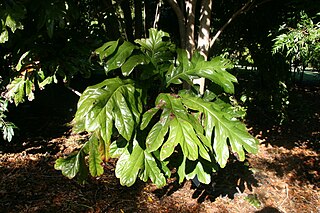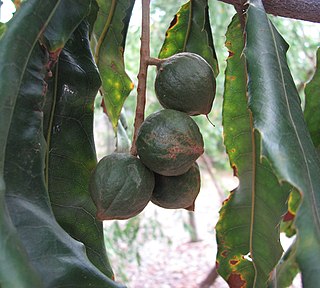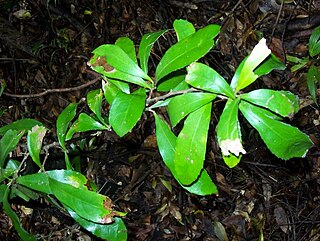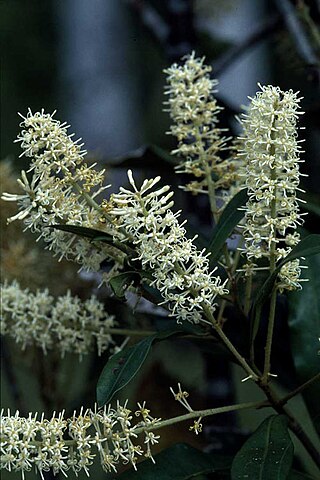
Macadamia is a genus of four species of trees in the flowering plant family Proteaceae. They are indigenous to Australia, native to northeastern New South Wales and central and southeastern Queensland specifically. Two species of the genus are commercially important for their fruit, the macadamia nut. Global production in 2015 was 160,000 tonnes. Other names include Queensland nut, bush nut, maroochi nut, bauple nut and, in the US, they are also known as Hawaii nut. It was an important source of bushfood for the Aboriginal peoples.

Floydia is a monotypic genus of plants in the Proteaceae family endemic to Australia. The sole described species is Floydia praealta, commonly known as the ball nut. It is a somewhat rare tree found only growing in the rainforests of southeastern Queensland and northeastern New South Wales. The tree has a superficial resemblance to the closely related Macadamia and could be confused with them. The fruit is poisonous.

Athertonia is a monotypic genus of plants in the family Proteaceae. The sole described species is Athertonia diversifolia, commonly known as Atherton oak, athertonia, creamy silky oak or white oak. It is endemic to a small part of the Wet Tropics of Queensland, Australia. A relative of the macadamia, it has potential in horticulture and the bushfood industry.

Macadamia tetraphylla is a tree species in the family Proteaceae native to Australia. Common names include macadamia nut, bauple nut, prickly macadamia, Queensland nut, rough-shelled bush nut and rough-shelled Queensland nut.

Macadamia integrifolia is a small to medium-sized tree native to Australian rainforests. Common names include macadamia, smooth-shelled macadamia, bush nut, Queensland nut, Bauple nut and nut oak.

Cardwellia is a monotypic genus in the plant family Proteaceae. The sole described species is Cardwellia sublimis − commonly known as northern silky oak, bull oak or lacewood − which is endemic to the rainforests of northeastern Queensland, Australia.

Hicksbeachia pinnatifolia is a small tree in the family Proteaceae. Common names include red bopple nut, monkey nut, red nut, beef nut, rose nut and ivory silky oak.

Elaeocarpus bancroftii, commonly known as Kuranda quandong, Johnstone River almond, ebony heart, grey nut, or nut tree is a large rainforest tree in the family Elaeocarpaceae which is endemic to Queensland. It has coriaceous leaves, attractive white flowers and relatively large fruit containing an edible kernel.

Cryptocarya triplinervis, commonly known as blackbutt, three-veined cryptocarya, brown laurel or three-veined laurel, is a species of flowering plant in the family Lauraceae and is endemic to eastern Australia. It is a tree with egg-shaped to elliptic or lance-shaped leaves, cream-coloured to pale green flowers, and elliptic black drupes.

Hakea decurrens, commonly known as bushy needlewood, is a species of shrub or small tree in the family Proteaceae.

Endiandra discolor is a tree in the family Lauraceae, native to eastern Australia from central New South Wales to northeastern Queensland. Common names include rose walnut and domatia tree. It grows in tropical, subtropical or warm temperate rainforest, particularly on the poorer volcanic soil types, and alluvial soil near streams. It was first described in 1870, and has been given the conservation status of least concern.

Helicia glabriflora is a species of rainforest shrubs or small trees occurring in eastern Australia. Common names include smooth or pale helicia, pale, leather or brown oak. They grow naturally in a variety of different rainforest types from the Illawarra, New South Wales to the Townsville area, Queensland. Of all the global diversity of approximately one hundred Helicia species, this one species naturally grows the furthest south, in the Minnamurra Rainforest and the Robertson area, Illawarra, New South Wales, there observed more on the relatively fertile basalt and alluvial soils.

Cinnamomum virens is a rainforest tree growing in the eastern coastal region of Australia. Common names include red-barked sassafras, black sassafras, camphorwood, scentless cinnamon wood, and native camphor laurel. Its habitat is between the Williams River and the Main Range National Park in Queensland. Growing in rich volcanic soils or on poorer sedimentary soils, it is often in association with coachwood.

Endiandra compressa, commonly known as whitebark or greenheart, is a rainforest tree in the Lauraceae family endemic to eastern Australia. It was first described in 1919 and has been given the conservation status of least concern.

Petalostigma triloculare, known as the long-leaved bitter bark is a rainforest tree of eastern Australia. It occurs in the drier rainforests, often on sandy soil derived from granite or sandstone, and is sometimes seen on old sand dunes.

Leionema elatius, commonly known as tall phebalium, is a shrub species that is endemic to New South Wales and Queensland in Australia. It has glossy green, variably-shaped leaves and clusters of white-lemon flowers in spring.

Opisthiolepis is a monotypic genus of trees in the macadamia family Proteaceae. The sole species is Opisthiolepis heterophylla, commonly known as blush silky oak, pink silky oak, brown silky oak or drunk rabbit. It was first described in 1952 and is endemic to a small part of northeastern Queensland, Australia.

Nothorites is a monotypic genus in the macadamia family Proteaceae. The sole species, Nothorites megacarpus, is endemic to the wet tropics rain forests of northeastern Queensland, Australia.

Persoonia iogyna is a species of flowering plant in the family Proteaceae. It is endemic to south-eastern Queensland, Australia. It is an erect shrub or small tree with hairy young branchlets, narrow elliptical to lance-shaped leaves, yellow flowers and green fruit.

Balanops australiana, commonly known as pimplebark, is a plant in the family Balanopaceae found only in the coastal regions of northern and central Queensland, Australia.






















